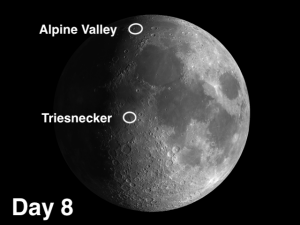The week of July 8-14 takes us from Day 7 to the end of Day 12. This week we will highlight the crater Triesnecker and the Alpine Valley (Vallis Alpes) viewable on Tuesday evening.
 Triesnecker: [NE/J10] This crater is located in Sinus Medii (Central Bay), the southern portion of which is ground zero on the Moon (latitude 0°, longitude 0°). Triesnecker is a good illustration of what a complex crater looks like. It has a central peak, terraces, and unusually large amounts of slump material that has separated from the western rim and fallen onto the floor. This would have been a spectacular landslide, creating a wave of material that slammed all the way to the central mountain nearly 6 miles away! You can see that significant slumping has occurred on the east rim also.
Triesnecker: [NE/J10] This crater is located in Sinus Medii (Central Bay), the southern portion of which is ground zero on the Moon (latitude 0°, longitude 0°). Triesnecker is a good illustration of what a complex crater looks like. It has a central peak, terraces, and unusually large amounts of slump material that has separated from the western rim and fallen onto the floor. This would have been a spectacular landslide, creating a wave of material that slammed all the way to the central mountain nearly 6 miles away! You can see that significant slumping has occurred on the east rim also.
 Alpine Valley: [NE/E10] This is one of the Moon’s major attractions. The valley is 120 miles long and 6 miles wide. When the Imbrium basin was formed 3.9 billion years ago, the resulting stresses produced two parallel fault lines in this area of the lunar Alps. The lines pulled apart and the terrain in between dropped away to produce this lovely valley (technically called a graben). Try to catch it right after sunrise as the photogenic effect diminishes with a higher Sun angle.
Alpine Valley: [NE/E10] This is one of the Moon’s major attractions. The valley is 120 miles long and 6 miles wide. When the Imbrium basin was formed 3.9 billion years ago, the resulting stresses produced two parallel fault lines in this area of the lunar Alps. The lines pulled apart and the terrain in between dropped away to produce this lovely valley (technically called a graben). Try to catch it right after sunrise as the photogenic effect diminishes with a higher Sun angle.
There is a challenging object running straight down the middle of the Alpine Valley, and you really should persist until you have seen it. A stream of hot lava had cut a tiny rille meandering down its middle. The rille is visible through a 5″ refractor (provided that you have excellent optics and great seeing). An 8-inch telescope will increase your chances considerably.
======================
It is highly recommended that you get a copy of Sky and Telescope’s Field Map of the Moon, the very finest Moon map available for use at the telescope. It is available for $10.95 at www.skyandtelescope.com and on Amazon. All features mentioned in this blog will be keyed to the grid on the Field Map and will look like this: Plato: [NW/D9]
Credits:
Courtesy of Gray Photography of Corpus Christi, Texas
Lunar photos: NASA / USGS / BMDO / LROC / ASU / DLR / LOLA / Moon Globe. Used by permission
- Rupes Cauchy: A Best Known Fault on the Moon - July 22, 2024
- Moon Crater Schickard – Crater Floor has Stripes - July 15, 2024
- Moon Craters Langrenus and Vandelinus - July 8, 2024